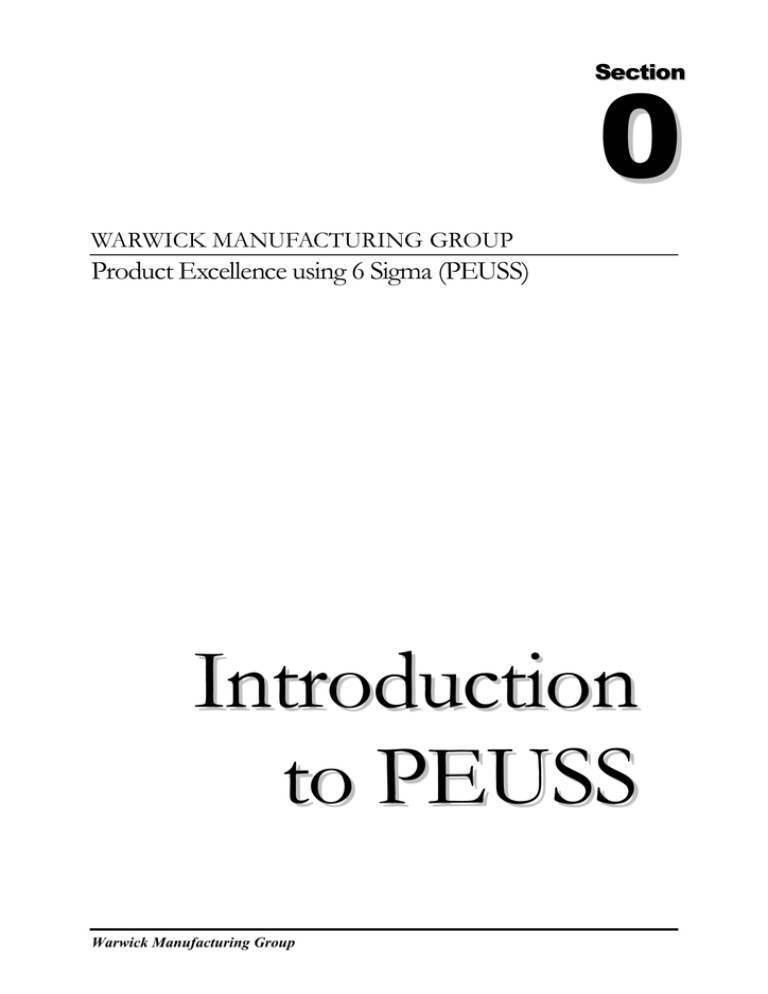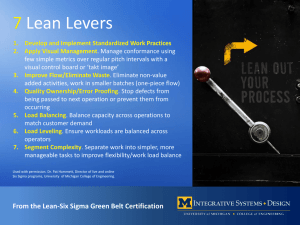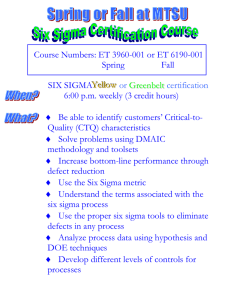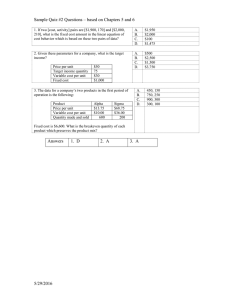
0
Section
WARWICK MANUFACTURING GROUP
Product Excellence using 6 Sigma (PEUSS)
Introduction
to PEUSS
Warwick Manufacturing Group
PRODUCT EXCELLENCE USING SIX
SIGMA (PEUSS)
Contents
1
Introduction
1
2
Learning Objectives
1
3
Module Contents
1
4
Duration
2
5
Assessment
2
6
PEUSS tutors
2
7
Reference Material
3
Copyright © 2007 University of Warwick
Warwick Manufacturing Group
QRM
Page 1
PRODUCT EXCELLENCE USING SIX SIGMA
(PEUSS)
1 Introduction
This module will enable participants to understand how organizations develop, manage and
plan design processes to support policy and strategy and fully satisfy, and generate increasing
value for customers and other stakeholders. It uses the design for six sigma methodology as
an approach to design for excellence. In particular it focuses on the management and
reduction of risk as well as capturing customer requirements. It also considers all the factors
affecting excellence in design.
2 Learning Objectives
On completion, participants will be capable of:
1. Understanding the fundamental concepts of technical and business risk, its
management, identification and reduction within the context of New Product
Introduction (NPI).
2. Understanding the Design for Six Sigma (DFSS) approach to product excellence and
the importance of Design for X..
3. Understanding the importance of capturing customer requirements and assessing
compliance.
4. Recognising the importance of project management and planning.
5. Evaluating the methods and tools for accurate requirements capture in designing a
product.
6. Recognising the wide variety of factors that need to be addressed when designing a
product.
7. Assessing and managing business and technical risk.
8. Understanding how to design products to deliver customer requirements.
9. Critical analysis of product design plans.
10. Understanding how to design products efficiently and effectively for reliability, life,
maintainability, testability and environment.
3 Module Contents
1. Design for Six Sigma Define, Measure, Analyse, Design and Verify and associated
tools.
2. An introduction to New Product Introduction
3. Translation of Voice of the Customer (VOC) to design requirements
Warwick Manufacturing Group
QRM
Page 2
4. Quality Function Deployment
5. Measuring Critical to quality characteristics using scorecards of key characteristics
6. Design for X (X is life and reliability, manufacture and assembly, maintainability,
testability)
7. Identification of Technical and business risk
8. Design reviews
9. Eliciting expert judgement of engineering concerns and developing project risk
registers
10. Failure Modes Effects Analysis
11. Testing during the design process
12. Setting-up, running and evaluating improvement projects.
4 Duration
5 days
5 Assessment
5.1 In-module assessment
The in-module assessment will be a group project. The questions for each project will be
allocated on the week prior to the module. Time will be given throughout the module for selfstudy and a presentation by the group will be given toward the end of the module. The
assessment will be based on the content, presentation and ability to research and answer the
question. It will account for 30% of the module mark.
5.2 Post-module assessment
The post-module assessment will be given out at the end of the module. It will consist of a
number of essay type questions of which three should be answered. Six weeks will be allowed
for completion of the assignment and will account for 70% of the overall module mark. The
purpose of this assessment is to test the depth of knowledge of the subject and the material.
It is expected that some additional reading will be necessary to achieve a good score on this
assignment.
6 PEUSS tutors
Module Tutor: Dr Jane Marshall
Room Number: IMC324
Warwick Manufacturing Group
QRM
Page 3
Email: Jane.marshall@warwick.ac.uk
Other tutors: Paul Roberts,
7 Reference Material
7.1 Books
Creveling, Slutsky and Antis, (2003). Design for Six Sigma, Prentice Hall.
Gitlow, Levine and Popovich (2006), Design for Six Sigma for Green Belts and Cha,pion,
Pearson, Prentice-hall
Akao, (1990). Quality Function Deployment, Productivity press.
Chapman and Ward (2003). Project risk management, John Wiley.
Burgess(1984). Design assurance for engineers and managers, Marcel-Dekker
O’Connor (2002). Practical reliability engineering, John Wiley.
Stamatis (2003). FMEA from theory to execution, ASQ Quality press.
UK Defence standard 00-40: The management of reliability and maintainability,
HMSO. British Standard BS5760: Reliability of systems, equipments and components,
British Standards Institution.
O’Connor (1994). The practice of engineering management, John Wiley.
Shuna, (2002). Six sigma for electronics design and manufacturing, McGraw-Hill
Tennant (2002). Design for six sigma: Launching new products and services without failure.
Gower publishing limited
Yang (2003). Design for six sigma. McGraw-Hill
Pande (2005). What is design for six sigma. McGraw-Hill
Lou. Quality Function Deployment: How to Make QFD Work for You. Addison-Wesley
Mizuno and Akao (1994). QFD: The Customer-Driven Approach to Quality Planning &
Deployment. Asian Productivity Organisation
Breyfogle III, F. W. (1999) Implementing Six Sigma, Wiley-Interscience, New York. USA
Yang, K., Basem, E. (2003) Design For Six Sigma. Mc-Graw-Hill, New York. USA.
Johnson, G., Scholes K. (1999) Exploring Corporate Strategy, 5th Edition, Prentice Hall
Europe, England.
Chowdhury, S. (2002) The Power of Design For Six Sigma. Dearborn Trade Publishing. USA
Warwick Manufacturing Group
QRM
Page 4
Brue. G. (2003) Design For Six Sigma. McGraw-Hill, New York, USA
7.2 Published Papers
Diomidis. D, Stamatis. H, (2003) Design for Six Sigma (DFSS) and Reliability, SAE
International, Detroit, USA.
Wasiloff. J. M, Basem. E. (2004) Practical Application of DFSS with a Focus on Axiomatic
Design – A Transmission Planetary Case Study, SAE International, Detroit, USA.
Hu, M. Pieprzak, J. M. & Glowa. J. (2004) Essentials of Design Robustness in Design for Six
Sigma (DFSS) Methodology. SAE International, Detroit, USA.
Hu, M. Pieprzak, J. M. Barth, B. Sears, R. (2004) Six Sigma Disciplines Utilizing Design for
Six Sigma Strategy in Automotive Applications. SAE International, Detroit, USA.
Puaar, S. (2003) MC Meets DFSS: Design For Six Sigma One Route To Unravelling The
Potential Complexities Of Mass Customization. IEE Manufacturing Engineer.
Tennant, G. (2002) Design for Six Sigma: Launching New Products and Services Without
Failure. The TQM Magazine, Volume 14 Number 4 2002.
J. Antony (2004) Design for Six Sigma: A Breakthrough Business Improvement Strategy For
Achieving Competitive Advantage. The TQM Magazine, Volume 51. Number 1. 2002. pp. 6-8
Banuelas, R., J. Antony (2004) Six Sigma Or Design For Six Sigma? The TQM Magazine,
Volume 16. Number 4. 2004. pp. 250-263
Banuelas, R., J. Antony (2003) Going From Six Sigma To Design For Six Sigma: An
Exploratory Study Using Analytic Hierarchy Process. Volume 15, Number 5 2003 pp 334 344
Søren, B., Johannes, F (2004) Six Sigma And The Bottom Line, Quality Progress, Bell &
Howell Information and Learning Company. USA.
Harry, M. J., Crawford, J. D., (2004) Six Sigma For The Little Guy. Mechanical
Engineering-CIME. U.K.
Snee, R. D. (2004) Weave Six Sigma Into The Fabric of an Organization. Quality Progress,
Bell & Howell Information and Learning Company. USA.
Crawford, D. (2000) Design For Six Sigma – IDOV Methodology, iSix Sigma LLC. USA.
Phadnis, Shree. Design For Six Sigma Roadmap, iSix Sigma LLC. USA.
Weston-Hemphill, K. (2000) Designing Financial Services with DMEDI, iSixSigma LLC.
USA.
Warwick Manufacturing Group
QRM
Page 5
Simon, K. (2000) DMAIC Vs. DMADV, iSix Sigma LLC. USA.
Shah, Himanshu. (2000) Not Just Statistics: Implementing The Cultural Change. iSix Sigma
LLC. USA.
Smith, L.R. (2001) Six Sigma And The Evolution of Quality In Product Development. Six
Sigma Forum Magazine. USA.
Huber, C., Luansby, R. (2002) Straight Talk On DFSS. Six Sigma Forum Magazine. USA.
Simon, K. (2000) What is DFSS. ISix Sigma LLC. USA.
Fellenstein S. J. (1999) Dishing Up Success. General Electric Appliances. USA.
Tennant. G. (2004) http://www.eurosixsigma.com/DFSS/whatis_dfss.htm,
British Standards
ISO 8402
Definitions for Quality, Reliability & Maintenance
B
BS 5700
Statistical Process Control
B
BS 5703
Guide to Data Analysis and Quality Control using Cusum B
Techniques
ISO 9000
Quality Systems, Parts 0,1,2,3,& 4
B
ISO 9000
Part 4(b) Quality Systems for the Service Industry
B
BS 5760
Parts 1-3 Reliability of Systems, Equipments and Components
B
BSI Handbook 22, Quality Assurance, ISBN 0 580 183653
C
Warwick Manufacturing Group




